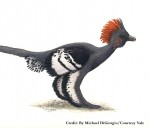Paint By Number Dinos: Paleontologists Reveal Dinosaurs’ True Colors
February 4, 2010

Two groundbreaking papers—one in last week’s journal Nature and the other in this week’s journal Science—have for the first time revealed the true colors of dinosaur feathers. Now it’s possible to illustrate what some dinosaurs looked like without having to guess.
The first team identified colors in isolated spots on several dinosaurs. The second team, which included Jackson School of Geosciences paleontologist Julia Clarke, went a couple of steps further:
First, they mapped out the colors and color patterns of an entire dinosaur from head to tail. They picked up color patterns not just across whole regions of feathers but also within individual feathers. The dinosaur in question is a 155-million-year-old Anchiornis huxleyi discovered in China. It was the size of a chicken and, as the new study reveals, had black and white stripes and splotches with a rusty red crown.
Second, Clarke combined this information with earlier studies that found evidence for dark and light bands on dinosaur feathers (based on a different technique that couldn’t identify specific colors) to learn more about the early evolution of feathers in dinosaurs. Scientists have debated why elongate feathers, a type used for flight in modern birds, appeared in dinosaurs long before they were actually capable of flight. Using cladistics, a technique for establishing evolutionary relationships between species and tracking changes in physical characteristics over time, she found what she was looking for.
“When elongate feathers first appear [in the fossil record], they are already distinctively spotted and striped,” Clarke is quoted as saying in a National Geographic News article. “We now have patterns within individual feathers in dinosaurs long before we get some kind of aerial locomotion.”
This, she says, adds more weight to the hypothesis that early on, feathers were used not for flight but for display. In other words, they might have helped attract mates, provide camouflage, confuse predators, frighten prey, or establish territory.

It was Clarke’s colleague Jakob Vinther, a Yale graduate student, who first developed the technique for identifying colors in fossil bird feathers in 2008. It involves microscopic structures in the feathers called melanosomes. In living birds, the shapes, sizes and arrangement of these molecules give feathers their colors.
Despite making it into print a week after last week’s Nature article, Clarke and her colleagues began their work on feather color before the other team. That team, led by Fucheng Zhang of China’s Institute for Vertebrate Paleontology and Mike Benton of the University of Bristol in England, had been studying other aspects of dinosaur feather preservation when they read about the work of Vinther, Clarke, and their colleagues. They quickly realized that what they saw in their fossil dinosaur specimens were not fossil bacteria but melanosomes. The Zhang-Benton study proved the concept could work in dinosaurs, while this week’s research brings an entire dinosaur to life in Technicolor.
by Marc Airhart
Also See:
Plumage Color Patterns of an Extinct Dinosaur (Science)
True-Color Dinosaur Revealed: First Full-Body Rendering (Nat. Geographic) (great 3-D animation)
Yale Scientists First to Reveal Flamboyant Colors of a Dinosaur’s Feathers (Yale Univ.)
Ancient dinosaur had stripes, researchers say (AP)
Evidence Builds on Color of Dinosaurs (NY Times)
Fossil Birds & Dinosaurs in Technicolor (JSG)
Fossilized melanosomes and the colour of Cretaceous dinosaurs and birds (Nature)
For more information about the Jackson School contact J.B. Bird at jbird@jsg.utexas.edu, 512-232-9623.
